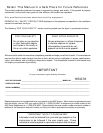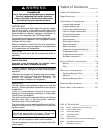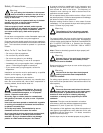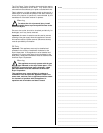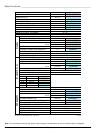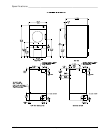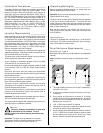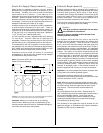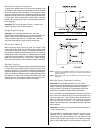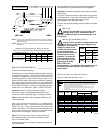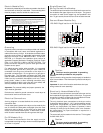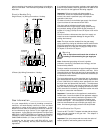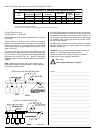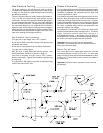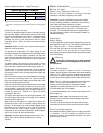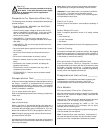
10 American Dryer Corp. 113615-1
NOTE 1 Opening from combustible materials must be 2-inches (5.08 cm)
larger than the duct (all the way around). The duct must be centered
within this opening.
NOTE 2 Distance should be 2 times the diameter of the duct to the nearest
obstruction.
Multiple Dryer (Common) Venting
Important: For extended ductwork runs, the cross-
sectional area of the ductwork can only be increased to an
extent. When the ductwork approaches the maximum
limits as noted in this manual, a professional HVAC firm
should be consulted for proper venting information.
If it is not feasible to provide separate exhaust ducts for each
dryer, ducts from individual dryers may be channeled into a
“common main duct.” The individual ducts should enter the
bottom or side of the main duct at an angle not more than
45º in the direction of airflow. The main duct should be
tapered, with the diameter increasing before each individual
duct is added.
Important: No more than 4 dryers should be connected to
1 main common duct.
The illustration on the next page shows the minimum cross-
sectional area for multiple dryer round or square venting.
These figures must be increased if the main duct run from
the last dryer to where it exhausts to the outdoors is longer
than 12 feet (3.656 meters) or has more than 1 elbow in it.
A = 20 feet (6.10 meters)
B = 8” (20.32 cm)
Outside Ductwork Protection
To protect the outside end of the horizontal ductwork from
the weather, a 90° elbow bent downward should be installed
where the exhaust exits the building. If the ductwork travels
vertically up through the roof, it should be protected from the
weather by using a 180° turn to point the opening downward.
In either case, allow at least twice the diameter of the duct
between the duct opening and the nearest obstruction (refer
to the diagram).
Important: Do not use screens, louvers, or caps on the
outside opening of the exhaust ductwork.
Single Dryer Venting
Important: For extended ductwork runs, the cross-
sectional area of the ductwork can only be increased to an
extent. When the ductwork approaches the maximum
limits as noted in this manual, a professional HVAC firm
should be consulted for proper venting information.
Horizontal Venting
When horizontal dryer venting is used, the length of the
ductwork from the dryer to the outside exhaust outlet, must
not exceed 20 feet (6.10 meters). The minimum diameter of
this ductwork must be at least 8-inches (20.32 cm). Including
tumbler/dryer elbow connections or elbows used for outside
protection from the weather, no more than 1 elbow should be
used in the exhaust duct run. If more than 1 elbow is used,
the cross-sectional area of the ductwork must be increased.
Vertical Venting
When vertical dryer venting is used, the length of the ductwork
from the dryer to the outside exhaust outlet, must not exceed
20 feet (6.10 meters). The minimum diameter of this ductwork
must be at least 8-inches (20.32 cm). Including tumbler/dryer
elbow connections or elbows used for outside protection from
the weather, no more than 3 elbows should be used in the
exhaust duct run. If more than 3 elbows are used, the cross-
sectional area of the ductwork must be increased.
C = 20 feet (6.10 meters)
D = 8” (20.32 cm)



